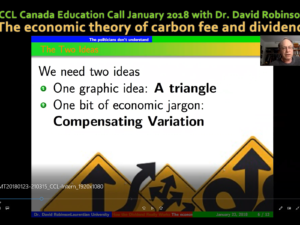LASER TALK: How Revenue-Neutral Carbon Pricing Alone Will Spur Low-Carbon Investments In 2018, Canada will establish a floor price on carbon pollution of $10/tonne, rising to $50/tonne by 2022. The federal government will provide a carbon pricing system for provinces and territories that do not adopt their own systems. For the carbon price to reduce emissions significantly, it must continue to rise past 2022 and reach at least $150/tonne by 2030[1]. A simple projection by CCL Canada members shows this could increase the cost of living throughout most of the 2030’s to approximately $2,000 per person per year [2]. There are already rumblings of a populist tax revolt over the cost of cap and trade in Ontario, estimated to be about $140 per person per year [3]. Imagine the outcry at $2,000. The clear lesson is that high carbon prices will impose unacceptable costs on consumers. CCL has always proposed offsetting these carbon pricing costs with dividends to households, i.e. being revenue neutral. However, others have opposed revenue neutrality. [4] They want the government to invest the revenue in various ways to help the transformation to a low-carbon economy.[5] They ask, “where else will the investment money come from?” The simple answer is that higher fossil fuel costs will spur the investment needed for this transformation much more efficiently than would government spending. A high carbon tax will stimulate the revenue stream for low carbon options because their competition (fossil fuels) becomes costlier. This creates attractive private and public investment opportunities resulting in loans being approved and capital being redirected (e.g. from new fossil infrastructure). This will also mobilize currently under-utilized resources – labour and capital – thereby creating wealth and distributing it more widely. The massive transformation infrastructure needed will require the participation of more than just the government. Carbon pricing will also redirect public investment. Public sector projects are often evaluated on a “triple bottom line” (economics, social, environment), but economics is still a driver. For example, higher fossil fuel prices brought about by carbon pricing will, for example, make weatherizing buildings more attractive for public housing. The dividends to households will provide significant new income for the poor and disadvantaged. This will serve social justice and stimulate the economy. For example, cash-poor homeowners could better afford to weatherize. Increased carbon costs will hurt the poor most (since they spend a large fraction of their income on bare necessities), while dividends will benefit the poor most because they consume fewer carbon-intensive goods and services. In conclusion, a revenue-neutral carbon pricing scheme will spur investment needed for the transition to a low carbon economy through price signals, which redirect investments in the public and private sectors, and by providing consumers with funds to invest in their own energy improvement upgrades. What is required from the government is the long-term commitment to rising carbon fees. That is why CCL advocates for a national and revenue neutral carbon fee, rising predictably to $150/tonne by 2030. See other Laser Talks: References: [2] CCL member Michael Wiggin, P.Eng. created a simple Excel spreadsheet (available on request from John Stephenson) with these key assumptions: 100% pass through of tax to consumers, tax applied to all emissions (732 Mt) at the rate of $30/tonne in 2018 rising at $10/tonne/year to $200/tonne, following a curve resulting in 30% emission reduction by 2030 and 80% reduction by 2050 (Canada’s goal), population 36 million, population growth 0.8%. As an order of magnitude sanity check, consider Canadian’s per capita annual consumption of 20 tonnes, reduced by 30% by 2030 = 14 tonnes multiplied by 150 $/tonne = $2,100). [3] Toronto Sun, February 9, 2017 Cost of cap-and-trade just doubled: “The Wynne government expects to make $1.9 billion in 2017 from the cap and trade market … this means the average cost of cap and trade per household this year will be $339.98 ($1.9 billion divided by 5,598,391 households)”. This is equivalent to $140 per person ($1.9 billion divided by 13.6 million population of Ontario. [5] Canada’s Ecofiscal Commission, April 2016, Revenue Recycling: Six Position Papers
“Why we want 100% revenue neutrality”, “Balancing the Budget, Social Concerns and the Environment” and How a Clear Market Signal Will Spur Investment .
[1] Economic modeling by Navius Research shows that a price of $100/tonne by 2030 is not enough to meet the current target of 524 Mt CO2e in 2030, suggesting a larger carbon price is necessary, especially since the current target is inadequate for Canada’s fair-share contribution to the Paris agreement. See figure 7 in: http://ecofiscal.ca/wp-content/uploads/2016/04/Ecofiscal-Commission-Choose-Wisely-Carbon-Pricing-Revenue-Recycling-Report-April-2016.pdf
LASER TALK: How Revenue-Neutral Carbon Pricing Alone Will Spur Low-Carbon Investments
Home » CCL Canada News » LASER TALK: How Revenue-Neutral Carbon Pricing Alone Will Spur Low-Carbon Investments
LASER TALK: How Revenue-Neutral Carbon Pricing Alone Will Spur Low-Carbon Investments
Posted on March 1, 2017 in Laser Talk




